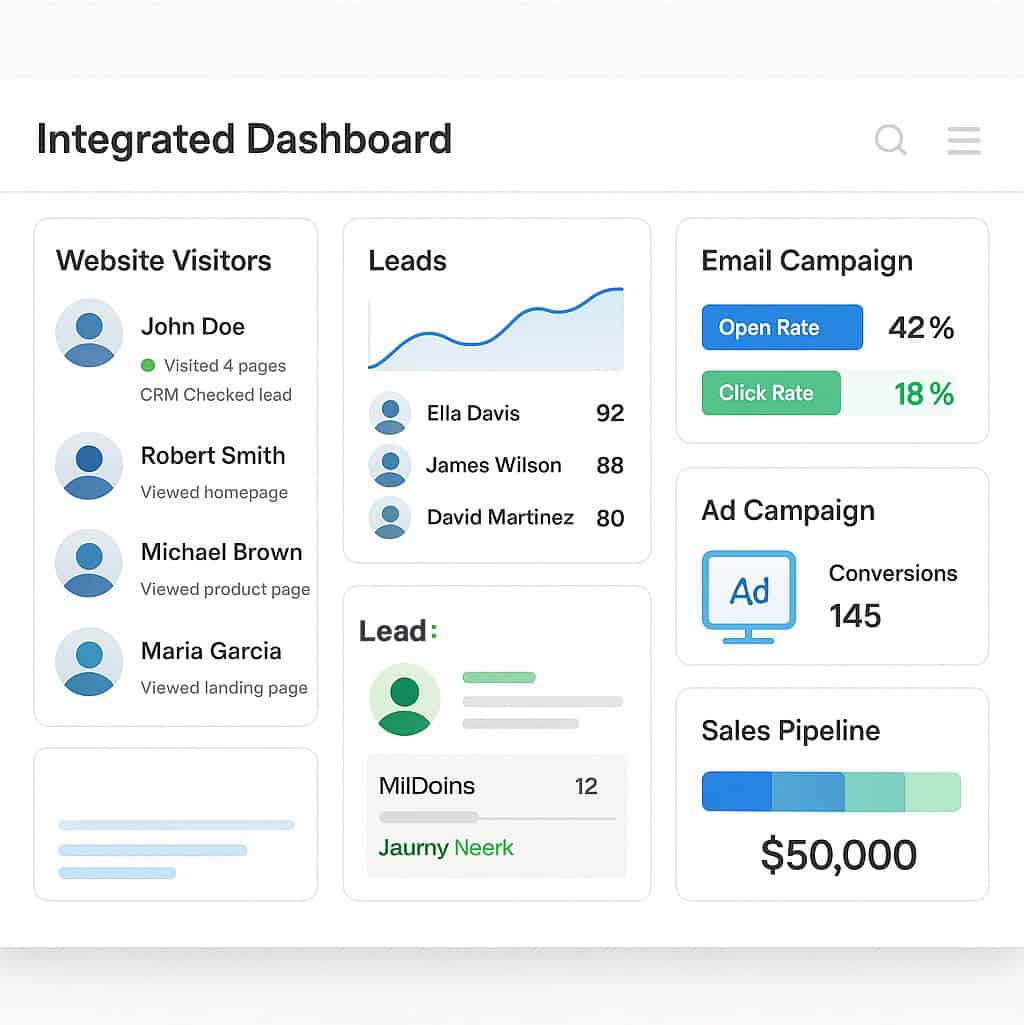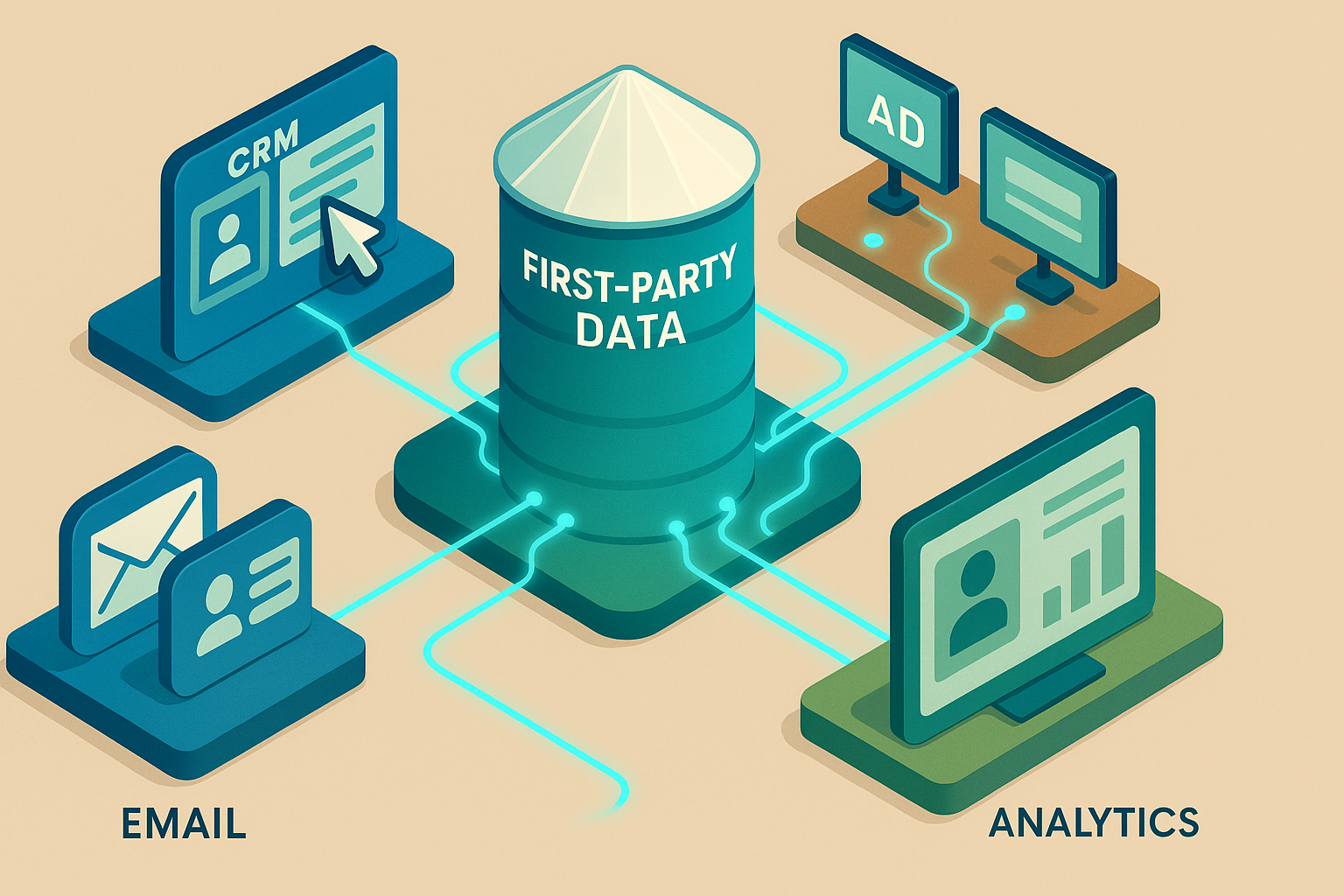We’ve covered how visitor identification works and the practical applications that generate revenue. Now let’s talk about integration—how this technology fits into your existing marketing systems to create a cohesive, efficient operation.
The Integration Imperative
One of the beauties of modern visitor identification systems is how seamlessly they integrate with tools you’re probably already using. This isn’t about replacing your entire marketing operation—it’s about enhancing it with better data.
The dealers who get the best results aren’t just installing visitor identification and hoping for magic. They’re thoughtfully connecting it to their existing systems so data flows automatically and marketing becomes more efficient rather than more complicated.
CRM Integration: Your Central Hub
Your Customer Relationship Management system is where identified visitors need to end up. Whether you’re using Salesforce, HubSpot, or an agriculture-specific CRM, visitor identification platforms typically offer direct integrations or API connections.

How It Should Work:
When someone visits your website and gets identified, that information should automatically create or update a lead record in your CRM. The record should include not just basic contact information, but the complete behavioral history: which pages they viewed, how long they spent on your site, how many times they visited, and what equipment they showed interest in.
Your sales team opens the CRM and sees leads with rich context. Instead of just “John Smith, 555-1234,” they see “John Smith, Smith Family Farms, 2,500-acre corn operation, visited site 4 times in past two weeks, spent total of 37 minutes viewing combine inventory, particularly interested in used Case IH models.”
That context transforms how your sales team works. They’re not calling blindly—they’re calling with relevant information that makes the conversation productive from the first moment.
Making It Happen:
Most modern CRMs have built-in integrations with popular visitor identification platforms. If not, Zapier or similar tools can bridge the gap. Work with your visitor identification provider to ensure the data mapping is correct—that fields from the identification platform correspond to the right fields in your CRM.
Set up lead scoring rules in your CRM based on visitor behavior. Someone who visits once might be a cold lead worth 10 points. Someone who visits five times and spends an hour on your site might be a hot lead worth 100 points. This scoring helps your sales team prioritize their outreach.
Email Marketing Platform Integration
For dealers using email marketing tools like Constant Contact, Mailchimp, or specialized agricultural marketing platforms, visitor identification data creates powerful segmentation opportunities.
How It Should Work:
Identified visitors should automatically be added to your email platform with tags based on their browsing behavior. Someone who viewed planter inventory gets tagged “Planter Interest.” Someone who spent time on financing pages gets tagged “Financing Interest.” Someone who visited from a large farm operation gets tagged “Large Operation.”
These tags enable sophisticated automation. Your email platform can automatically send relevant content sequences to people based on what they looked at on your website. No manual list building, no guesswork about what to send—just automated, relevant communication based on demonstrated interest.
Making It Happen:
Most email platforms integrate with visitor identification through native connections or middleware. Set up your tagging system thoughtfully—don’t create so many tags that management becomes overwhelming, but make them specific enough to enable meaningful segmentation.
Create automated email sequences for your most common interest areas. Someone interested in tractors should receive different emails than someone interested in hay equipment. Build these sequences once, then let automation handle delivery based on visitor identification tags.
Track performance religiously. You should see dramatically better open rates, click-through rates, and conversion rates on these targeted emails compared to broadcast messages. Use those insights to continuously refine your sequences.
Advertising Platform Integration
Advertising becomes far more efficient when you can target known website visitors rather than broad audiences. The high match rates possible with first-party data mean your ad dollars work harder.
How It Should Work:
Export lists of identified website visitors and upload them to Facebook, Google, LinkedIn, and other advertising platforms. Create custom audiences from these lists, then build ad campaigns that show specific messages to people who visited specific pages on your site.
Someone who browsed your used equipment inventory sees ads highlighting your current used inventory with competitive pricing. Someone who spent time on your parts pages sees ads promoting your parts department and quick shipping.
Beyond direct retargeting, use these high-quality audiences as seed data for lookalike audiences. Facebook and Google can find people similar to your website visitors, expanding your reach to likely prospects who haven’t found you yet.
Making It Happen:
Most visitor identification platforms offer direct audience syncing with major ad platforms. Set up automatic daily or weekly syncs so your advertising audiences stay current. Someone who visited yesterday should start seeing your ads today, not three weeks from now.
Create separate ad campaigns for different interest segments. Don’t show the same ad to everyone who visited your website—show different ads based on what they looked at. This requires more setup time initially but generates substantially better results.
Track your cost per acquisition carefully. You should see significantly lower costs when advertising to identified website visitors compared to cold audiences, because these people already know your brand and have expressed interest.
Analytics and Reporting Integration
Good visitor identification platforms don’t just collect data—they help you understand it through integrated reporting that shows you what’s working and what isn’t.
How It Should Work:
Your analytics dashboard should combine visitor identification data with traditional website metrics and sales outcomes. You want to see which traffic sources bring the highest-quality identifiable visitors, which website pages generate the most leads, what browsing patterns correlate with eventual purchases, and how many touchpoints typically occur before conversion.
This reporting helps you continuously refine your marketing strategy. Maybe you discover that blog posts about equipment maintenance generate surprisingly high-quality leads—worth investing more in content marketing. Or you find that visitors from organic search convert better than those from paid ads—suggesting you should prioritize SEO.
Making It Happen:
Look for visitor identification platforms with robust built-in reporting, or ensure they integrate with your existing analytics tools. Set up regular reporting cadences—maybe weekly operational reports and monthly strategic reviews.
Define your key performance indicators upfront. What metrics actually matter for your business? Probably things like: identification rate (percentage of visitors identified), lead quality scores, campaign conversion rates, cost per identified lead, and revenue attributed to visitor identification campaigns.
Website Personalization Integration
More advanced implementations use visitor identification to personalize website content in real-time for returning visitors. When someone comes back to your site, you can show them content related to what they previously viewed.
How It Could Work:
A visitor who previously spent time looking at planter inventory returns to your homepage. Instead of your generic homepage, they see featured planters and a special financing offer on planting equipment. Someone who looked at used tractors sees your latest used inventory prominently displayed.
This level of personalization increases engagement and conversion because you’re showing people exactly what they’re interested in, eliminating friction in their buying journey.
Making It Happen:
Website personalization requires more technical sophistication than basic visitor identification. You’ll likely need either a platform with built-in personalization capabilities or separate personalization software that integrates with your visitor identification system.
Start simple—maybe just personalizing your homepage for returning visitors. As you get comfortable, expand to personalizing other key pages, calls-to-action, and offers based on visitor history.
The Data Flow Architecture
When everything’s properly integrated, data flows seamlessly:
- Visitor comes to website and browses equipment
- Visitor identification pixel tracks behavior and identifies visitor
- Visitor profile with behavioral data flows to CRM as a lead
- Visitor is automatically added to email platform with interest tags
- Automated email sequence begins sending relevant content
- Visitor is added to advertising audiences for re-targeting
- Sales team receives alert about high-value visitor
- All interactions are tracked and attributed in analytics
This automation means your marketing runs 24/7 without constant manual intervention. You’re nurturing leads even while you sleep, following up with hot prospects immediately, and building relationships systematically rather than sporadically.

What’s Next
With the technology working and integrations in place, the critical questions become practical: How do you measure success? What metrics actually matter? And how do you optimize your system for better and better results? Part 5 will cover the measurement and optimization framework that separates dealers getting modest results from those generating extraordinary ROI.


